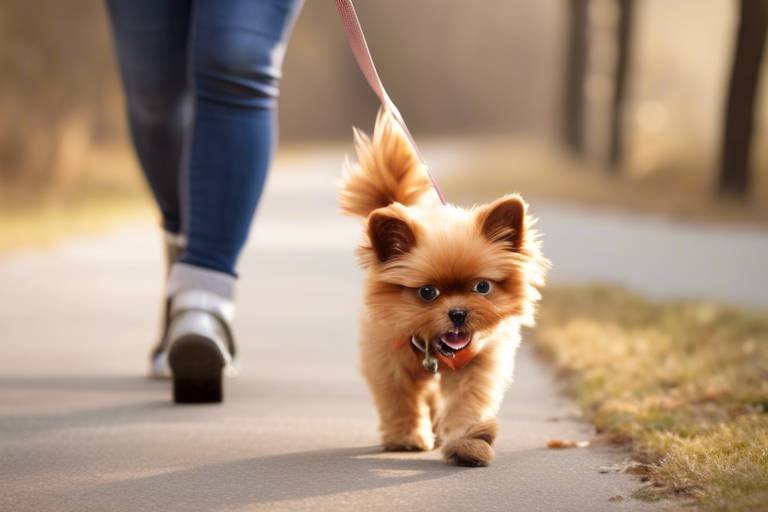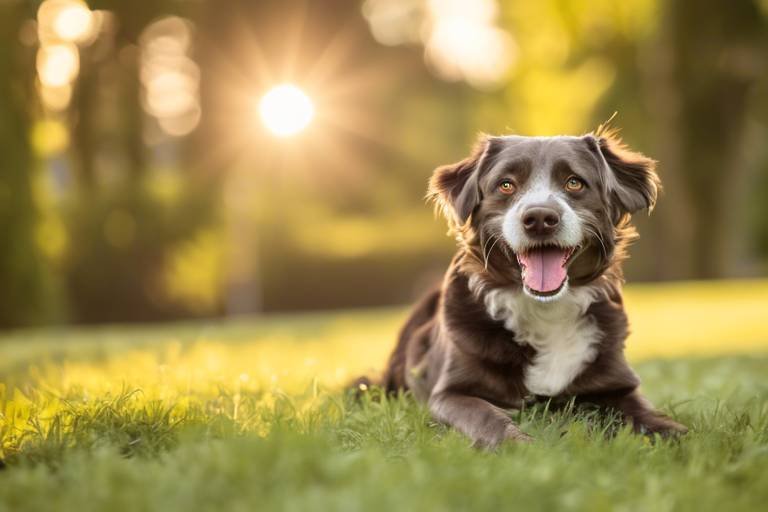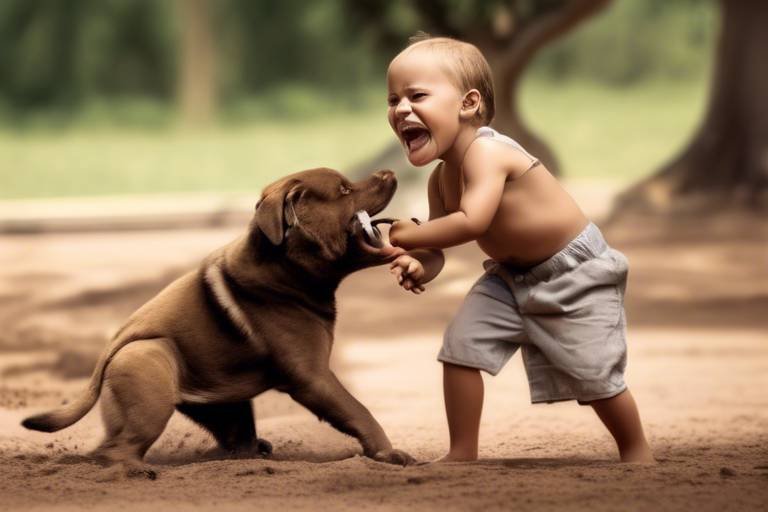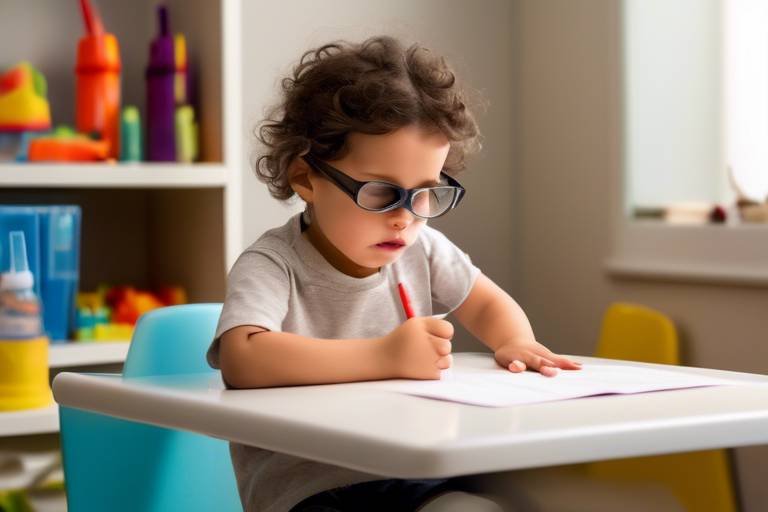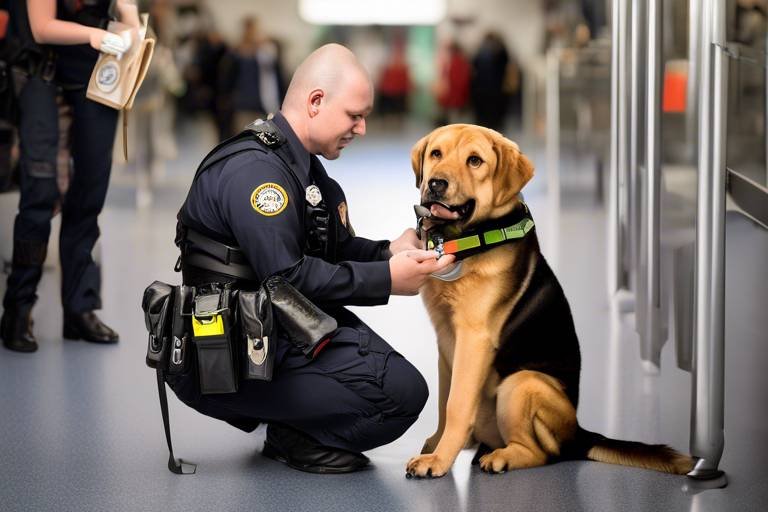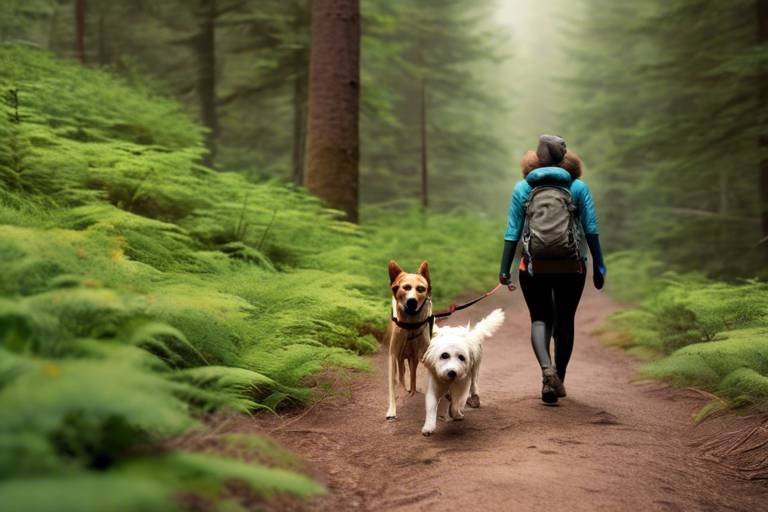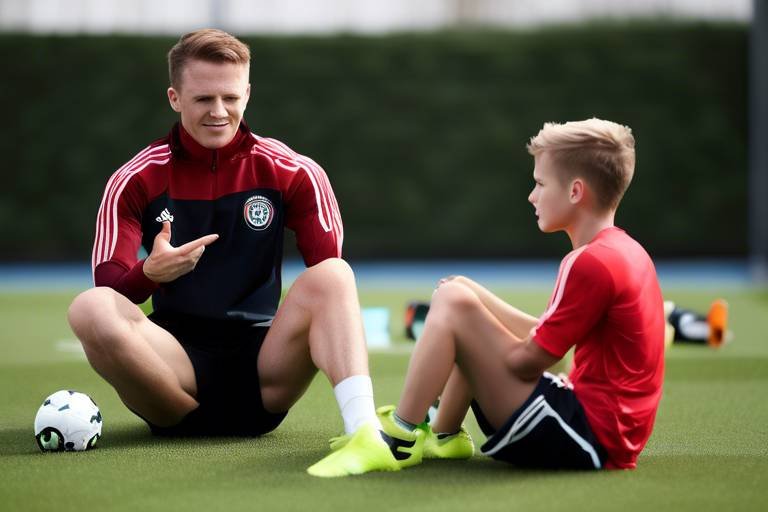The Role of Routine in Canine Behavioral Training
Establishing a consistent routine is one of the most effective ways to enhance your dog's behavioral training. Just like humans, dogs thrive on predictability and structure. Imagine trying to learn a new skill without any guidance or regular practice; it would be overwhelming, right? Well, that's precisely how your furry friend feels without a routine. By creating a structured environment, you not only improve your dog's obedience but also help reduce anxiety and foster a stronger bond between you and your pet. In this article, we will dive deep into the various aspects of routine in canine training, exploring its significance, how to set it up, and the positive impact it can have on your dog's behavior.
Consistency is the bedrock of effective training. When you maintain a regular training routine, you help your dog understand what is expected of them. Think of it like learning a new language; the more you practice, the more fluent you become. In canine training, regular practice reinforces positive behaviors and discourages unwanted actions. For instance, if you consistently reward your dog for sitting on command, they are more likely to repeat that behavior. On the flip side, if you are inconsistent with your commands or rewards, your dog may become confused, leading to frustration for both of you.
Creating a structured daily schedule for feeding, walks, and training sessions can significantly impact your dog's sense of security. Dogs are creatures of habit, and a predictable routine helps them feel more at ease in their environment. Imagine waking up every day to the same breakfast at the same time; it provides comfort and stability. Similarly, when you establish a routine for your dog, they learn to anticipate what comes next, which can alleviate anxiety and promote better behavior. Here’s a simple example of what a daily schedule might look like:
| Time | Activity |
|---|---|
| 7:00 AM | Feeding |
| 8:00 AM | Morning Walk |
| 9:00 AM | Training Session |
| 12:00 PM | Afternoon Playtime |
| 6:00 PM | Evening Walk |
| 7:00 PM | Feeding |
This schedule not only provides structure but also creates opportunities for bonding through shared activities.
Reinforcing commands through a routine is essential for shaping desired behaviors. When your dog associates specific actions with rewards, they are more likely to repeat those behaviors. Picture this: every time your dog successfully sits on command, you offer a treat or a praise. Over time, your dog begins to associate the command "sit" with the joy of receiving a reward. This consistent reinforcement is key to effective training and helps to solidify the learning process.
Utilizing positive reinforcement techniques within a routine can significantly enhance a dog's willingness to learn. Techniques such as treats, verbal praise, or even a favorite toy can motivate your dog to follow commands. When your dog knows that good behavior leads to something they love, they are much more likely to engage in training sessions. It’s all about making the experience enjoyable!
On the other hand, avoiding negative reinforcement is crucial in fostering a trusting relationship with your dog. Negative reinforcement can lead to fear and anxiety, which can hinder your training efforts. Instead of punishing your dog for mistakes, focus on positive interactions. Remember, training should be a fun and rewarding experience for both you and your dog. By concentrating on positive reinforcement, you build a bond of trust that encourages your dog to learn and grow.
It’s important to note that different dog breeds may require tailored routines based on their unique temperaments and energy levels. For example, a high-energy breed like a Border Collie may need more exercise and mental stimulation compared to a laid-back breed like a Bulldog. Adjusting your training routine to suit your dog's specific needs can lead to better outcomes. This might mean incorporating more playtime or longer walks for active breeds, while calmer breeds may benefit from shorter, more relaxed training sessions.
Incorporating socialization into a dog's routine is vital for developing well-rounded behavior. Regular interactions with other dogs and people can enhance training outcomes and help your dog become more adaptable to various situations. Think of socialization as a way for your dog to learn the "rules of the pack." The more they interact with others, the more they understand how to behave in different environments.
Participating in group training sessions can provide dogs with valuable social experiences. These sessions allow dogs to practice their commands in a stimulating environment, surrounded by other dogs and people. It’s like a classroom setting where they can learn not just from you, but also from their peers. This not only reinforces commands but also improves their social skills, making them more confident and well-adjusted.
Understanding the differences between individual and group training can help owners choose the best approach for their dog. Individual training offers a tailored experience focused solely on your dog's specific needs, while group training provides a social setting that can enhance learning. Both methods have their advantages, and often, a combination of both can yield the best results in establishing effective routines.
- How long should training sessions be? Training sessions should ideally last between 5 to 15 minutes, depending on your dog's attention span.
- What if my dog doesn't respond to commands? Be patient and consistent. It might take time for your dog to understand what you want.
- Is it too late to train an older dog? It's never too late! Dogs of any age can learn new tricks and behaviors.

The Importance of Consistency
When it comes to training your dog, consistency is the name of the game. Think of it like learning a new dance; if the steps keep changing, you're bound to trip over your own feet! Dogs thrive on routine and clear expectations, which is why establishing a consistent training regimen is crucial. Without it, your furry friend may feel confused and anxious, leading to a chaotic training experience that leaves both of you frustrated.
Imagine trying to learn a language where the rules change every day. That’s how your dog feels when training methods are inconsistent. By sticking to a specific routine, you help your dog understand what is expected of them. For example, if you always use the same command for sitting, your dog will quickly learn to associate that word with the action, making it easier for them to obey. This type of repetition not only speeds up the learning process but also reinforces positive behaviors.
Moreover, consistency in training helps to reduce anxiety in dogs. When they know what to expect, they feel more secure in their environment. A dog that is unsure of their surroundings is more likely to exhibit unwanted behaviors, such as barking or chewing on furniture. Here’s how consistency plays a role:
- Clear Expectations: Dogs learn best when they understand what is required of them. Consistent commands and cues make this learning process smoother.
- Reinforced Learning: Regular practice of commands leads to better retention, ensuring that your dog remembers what they've learned.
- Builds Trust: A consistent routine fosters a trusting relationship between you and your dog, leading to a deeper bond.
In essence, establishing a routine is not just about teaching commands; it’s about creating a stable environment where your dog can thrive. For instance, if you consistently reward your dog for sitting before meals, they’ll quickly learn to associate that action with the reward of food. This method of reinforcement is far more effective than sporadically rewarding good behavior.
So, as you embark on your training journey, remember that consistency is key. Whether it’s the commands you use, the timing of rewards, or the structure of your training sessions, keeping everything uniform will lead to a more obedient and happy dog. And who wouldn’t want that?

Creating a structured daily schedule for your dog isn't just about keeping things organized—it's about fostering a sense of security and understanding. Just like humans thrive on routines, dogs flourish when they know what to expect from their day. Imagine waking up each morning to a set plan: breakfast, a walk, playtime, and training sessions. This predictability helps reduce anxiety and creates a harmonious environment for both you and your furry friend.
A daily schedule can include various activities that cater to your dog's physical and mental needs. For instance, consider the following components when crafting your routine:
- Feeding Times: Regular meal times help regulate digestion and prevent overeating.
- Walks: Scheduled walks not only provide exercise but also mental stimulation through exploration.
- Training Sessions: Short, consistent training sessions reinforce commands and behaviors.
- Playtime: Engaging in play strengthens your bond and allows for healthy energy release.
When you establish a daily schedule, you're not just creating a checklist of activities; you're building a framework that allows your dog to feel secure in their environment. Dogs are creatures of habit, and when they know what to expect, they can relax and focus on learning. Think of it as laying the groundwork for a successful partnership. For example, if your dog knows that after breakfast comes a walk, they'll be more likely to remain calm and patient while waiting for their favorite part of the day.
Moreover, a consistent schedule can also help you as an owner. It allows you to allocate time effectively, ensuring that you’re meeting your dog’s needs without feeling overwhelmed. You can plan your day around your dog's schedule, making it easier to integrate training and socialization into your routine. Over time, you’ll notice that your dog becomes more obedient and responsive, as they thrive in an environment where they know the rules.
To illustrate how a daily schedule might look, here’s a simple example:
| Time | Activity |
|---|---|
| 7:00 AM | Feeding |
| 7:30 AM | Morning Walk |
| 8:00 AM | Training Session |
| 9:00 AM | Playtime |
| 12:00 PM | Feeding |
| 1:00 PM | Afternoon Walk |
| 3:00 PM | Training Session |
| 5:00 PM | Evening Playtime |
| 7:00 PM | Feeding |
| 8:00 PM | Evening Walk |
By following a schedule like this, you'll not only enhance your dog's training experience but also create a loving, secure atmosphere that encourages growth and learning. Remember, the goal is to make your dog feel like they are part of a well-structured family unit, where every member knows their role and responsibilities.
Q: How long should training sessions be?
A: Training sessions should be short and engaging, ideally lasting about 5-10 minutes. This keeps your dog focused and prevents boredom.
Q: What if my dog doesn't respond well to the schedule?
A: Every dog is unique; if your dog seems anxious or disinterested, consider adjusting the timing or the activities to better suit their needs.
Q: Can I change the schedule later?
A: Absolutely! Flexibility is key. As your dog grows and their needs change, feel free to adapt the schedule to keep it relevant.
When it comes to canine training, the reinforcement of commands is a game changer. Imagine teaching your dog to sit, and every time they do, you reward them with a treat or a loving pat. This simple yet effective method not only helps your furry friend understand what you expect but also makes them eager to learn more. By associating commands with positive outcomes, you create a strong connection between the behavior and the reward, leading to quicker learning and better retention of commands.
Think of it this way: every time you reinforce a command, you’re building a bridge of understanding between you and your dog. This bridge is constructed with patience, consistency, and, most importantly, positive reinforcement. Dogs thrive on routine, and when they know that sitting will earn them a tasty treat or a game of fetch, they are much more likely to respond to your commands. It's like training them to play a fun game where they always win!
Incorporating a structured routine into this reinforcement process can make a world of difference. For instance, if you consistently practice commands at the same time every day, your dog will start to anticipate these training sessions, making them more engaged and responsive. Here’s a simple example of how you can structure your reinforcement:
| Time | Activity | Reinforcement Method |
|---|---|---|
| Morning | Basic Commands (Sit, Stay) | Treats and Praise |
| Afternoon | Leash Training | Playtime as Reward |
| Evening | Advanced Commands (Roll Over) | Favorite Toy as Reward |
This table illustrates how you can incorporate reinforcement into your daily routine effectively. Each time your dog successfully follows a command, they receive a reward that reinforces their good behavior. Over time, this leads to a stronger understanding of commands and a more obedient companion.
However, it’s essential to remember that not all reinforcement methods are created equal. The key is to find what motivates your dog the most. Some dogs may respond better to treats, while others might prefer verbal praise or playtime. Experimenting with different reinforcement techniques can help you discover what makes your dog tick. This customization adds another layer of excitement to your training sessions, keeping both you and your dog engaged.
In summary, the reinforcement of commands is a vital component of canine behavioral training. By establishing a routine that incorporates consistent rewards, you pave the way for a well-behaved, happy dog. So, grab those treats, get ready to praise, and watch as your furry friend learns to obey commands with enthusiasm!
When it comes to training our furry friends, positive reinforcement techniques are the golden ticket to success. Imagine teaching your dog to sit or stay, and instead of scolding them for not getting it right, you shower them with praise and tasty treats when they do! This approach not only makes learning enjoyable for your dog but also strengthens the bond you share. Dogs, like humans, respond better to rewards than to punishment. So, why not create a training environment that feels like a fun game rather than a chore?
One effective method is to use a variety of rewards that keep your dog engaged. Think about it: if you were rewarded with the same snack every day, wouldn’t you get bored? Dogs are no different! Here are some popular types of rewards you can incorporate:
- Treats: Small, delicious morsels can be the ultimate motivator. Choose healthy options that your dog loves.
- Verbal Praise: A cheerful “Good boy!” or “Well done!” can make your dog feel like a superstar.
- Playtime: Sometimes, the best reward is a fun game of fetch or tug-of-war. This not only reinforces the behavior but also provides quality bonding time.
- Affection: A good scratch behind the ears or a belly rub can go a long way in making your dog feel appreciated.
Incorporating these rewards into a structured routine helps your dog understand what behaviors are desirable. For instance, if you consistently reward your dog for sitting before meals, they will learn to associate sitting with the arrival of their food. This creates a clear expectation: “If I sit, I get fed!” It's a simple yet powerful concept that reinforces good behavior.
Another key aspect of positive reinforcement is timing. You want to reward your dog immediately after they perform the desired action. This immediate feedback helps them make the connection between their behavior and the reward, enhancing their learning experience. Think of it like this: if you were praised for a job well done, wouldn’t you be more likely to do it again? The same principle applies to our canine companions.
Finally, remember that patience is vital. Every dog learns at their own pace, and what works for one may not work for another. Keep your training sessions short and fun, and don’t hesitate to mix things up to keep your dog engaged. The more enjoyable you make it, the more your dog will want to participate. After all, a happy dog is a trainable dog!
When it comes to training your furry friend, avoiding negative reinforcement is crucial for fostering a loving and trusting relationship. You see, dogs are incredibly sensitive creatures, and using negative methods can lead to fear and anxiety rather than the desired behavior. Think about it: if every time you made a mistake at work, your boss yelled at you, would you feel motivated to improve? Probably not! The same principle applies to our dogs. Instead of scolding or punishing them for unwanted behaviors, we should focus on guiding them towards positive actions.
Negative reinforcement often involves applying an unpleasant stimulus to discourage a behavior. For example, if a dog pulls on the leash and the owner yanks it back harshly, the dog may associate the leash with discomfort rather than understanding that pulling is not acceptable. Instead, why not redirect that energy? When your dog starts to pull, stop walking and wait until they return to your side. This approach teaches them that good things happen when they walk calmly beside you. It's all about creating a positive learning environment, where your dog feels safe and encouraged to explore new behaviors.
To illustrate the impact of negative reinforcement versus positive reinforcement, consider the following table:
| Method | Effect on Dog |
|---|---|
| Negative Reinforcement | Creates fear, anxiety, and mistrust |
| Positive Reinforcement | Encourages learning, builds confidence, and strengthens bond |
By focusing on positive reinforcement, you can create a training atmosphere that not only encourages your dog to learn but also strengthens your bond. This can be achieved through various techniques, such as offering treats, praise, or playtime whenever your dog successfully follows a command. Remember, every time your dog does something right, it's an opportunity to reward them and reinforce that behavior.
In conclusion, steering clear of negative reinforcement is essential for effective canine training. By nurturing a positive environment, you help your dog feel secure and confident, leading to better behavior and a happier relationship. So next time you find yourself frustrated with your dog's antics, take a step back, breathe, and shift your focus to what they can do right. Trust me; your pup will thank you for it!
- What is negative reinforcement in dog training? Negative reinforcement involves removing an unpleasant stimulus to encourage a desired behavior, but it can lead to fear and anxiety in dogs.
- How can I avoid negative reinforcement? Focus on positive reinforcement techniques, such as treats and praise, to encourage good behavior without using punishment.
- What are some examples of positive reinforcement? Examples include giving treats, verbal praise, or playtime when your dog follows commands or exhibits good behavior.
- Can negative reinforcement harm my dog? Yes, using negative reinforcement can create fear and anxiety, damaging the bond between you and your dog.
When it comes to canine behavioral training, one size definitely does not fit all. Just like humans, dogs have their own personalities, quirks, and energy levels, which can vary dramatically across different breeds. This means that adapting training routines to suit the specific needs of your furry friend is crucial for achieving the best results. For instance, a high-energy breed like a Border Collie will require a vastly different approach compared to a more laid-back breed like a Bulldog.
Understanding the unique characteristics of your dog's breed can help you tailor a routine that not only meets their physical needs but also engages their minds. For example, active breeds may benefit from longer training sessions that incorporate plenty of physical exercise, while more relaxed breeds might thrive with shorter, more focused training periods. Here’s a quick breakdown of how you might adapt routines based on breed characteristics:
| Breed Type | Training Routine Adaptations |
|---|---|
| High-Energy Breeds (e.g., Border Collie, Australian Shepherd) |
|
| Moderate-Energy Breeds (e.g., Labrador Retriever, Beagle) |
|
| Low-Energy Breeds (e.g., Bulldog, Shih Tzu) |
|
By customizing your training approach, you not only enhance your dog's learning experience but also strengthen the bond you share. It’s all about understanding what makes your dog tick and using that knowledge to create a routine that feels natural and enjoyable for them. Remember, the goal is to make training a fun and rewarding experience, rather than a chore. So, whether your dog is a sprightly Jack Russell or a mellow Great Dane, adapting their routine will lead to better obedience and a happier, more confident pup.
In conclusion, paying attention to your dog's breed characteristics and energy levels is essential in shaping an effective training routine. By doing so, you will not only foster better behavior but also pave the way for a loving and trusting relationship between you and your canine companion.
Q: How do I know what routine is best for my dog?
A: Observe your dog's energy levels, behavior, and preferences. Tailor the routine to fit their needs, incorporating physical exercise and mental stimulation as necessary.
Q: Can I change my dog's routine if it isn't working?
A: Absolutely! If you notice that your current routine isn't effective, feel free to adjust it. Dogs thrive on consistency, but they also benefit from routines that match their evolving needs.
Q: How often should I train my dog?
A: Training sessions can vary based on your dog's breed and age. Generally, short sessions (5-15 minutes) are effective for puppies, while adult dogs may benefit from longer sessions. Aim for daily training to reinforce learning.
Q: Is socialization part of a dog's routine?
A: Yes! Incorporating socialization into your dog's routine is vital for their development. Regular interactions with other dogs and people can significantly enhance training outcomes and ensure well-rounded behavior.

When it comes to training our furry friends, socialization plays a pivotal role in their overall behavior and well-being. Imagine this: your dog is like a sponge, soaking up experiences and learning how to interact with the world around them. By incorporating socialization into their daily routine, you’re not just teaching them to follow commands; you’re helping them develop essential life skills that will make them well-adjusted companions. Regular interactions with other dogs and people can significantly enhance training outcomes, leading to a happier and more confident pet.
Think about it—dogs are inherently social creatures. They thrive on interaction, and when they’re exposed to various environments and situations, they learn to adapt. A structured routine that includes socialization can help your dog understand social cues, build confidence, and reduce anxiety. For instance, scheduling regular playdates with other dogs or taking them to dog parks can provide valuable opportunities for your pup to practice their social skills. Not only does this keep them mentally stimulated, but it also reinforces the positive behaviors you’ve been working on during training.
Moreover, socialization isn’t just about letting your dog run wild with their furry friends. It’s about teaching them how to behave appropriately in different settings. By introducing your dog to new people, environments, and experiences in a controlled manner, you can help them learn to be calm and well-behaved. For example, if your dog is fearful of strangers, gradually exposing them to new people during walks or in your home can help them learn that not all humans are a threat. This is where a routine can be incredibly beneficial—consistently exposing them to new experiences can build their confidence over time.
To give you a clearer picture of how socialization fits into a routine, here’s a simple weekly schedule that incorporates socialization:
| Day | Activity | Socialization Focus |
|---|---|---|
| Monday | Morning Walk | Meet other dogs in the neighborhood |
| Tuesday | Training Session | Practice commands with distractions |
| Wednesday | Playdate | Interact with a known dog friend |
| Thursday | Visit Dog Park | Explore different dogs and people |
| Friday | Training Class | Learn commands in a group setting |
| Saturday | Family Outing | Exposure to new environments |
| Sunday | Rest Day | Relax and bond with the family |
This structured approach not only keeps your dog engaged but also helps reinforce their training in diverse situations. Remember, the goal is to create a well-rounded dog who can handle various social settings with ease. By making socialization a regular part of your dog's routine, you’re setting them up for success both at home and in public.
Ultimately, socialization is about building a strong foundation of trust and understanding between you and your dog. The more they experience, the more they learn, and the better they become at navigating the world around them. So, don’t underestimate the power of socialization in your training routine—it’s a game-changer!
- How can I tell if my dog is well-socialized? A well-socialized dog is comfortable around people and other dogs, shows curiosity without fear, and can handle new situations without excessive anxiety.
- What if my dog is shy or fearful? Start with controlled introductions to new experiences and gradually increase exposure. Patience is key!
- How often should I socialize my dog? Aim for a few social interactions each week, but adjust based on your dog’s comfort level and personality.
When it comes to canine behavioral training, group training sessions can be a game-changer. Imagine your dog not only learning commands but also socializing with other dogs in a controlled environment. It's like a classroom setting for pups! In these sessions, dogs get to practice their skills alongside peers, which can significantly enhance their learning experience. The presence of other dogs can motivate them to perform better, as they often want to impress their furry friends and their humans.
Group training sessions provide a unique opportunity for dogs to engage in positive social interactions. Not only do they learn to follow commands amidst distractions, but they also develop important social skills. For instance, they learn how to interact appropriately with other dogs, which is crucial for their overall behavior. Think of it as a mini doggy boot camp where they can refine their skills while making new friends!
Moreover, the benefits of group training extend beyond just the dogs. Owners also gain valuable insights into their pets' behaviors and training progress. Observing how other dogs respond to commands can offer new strategies and techniques that you can apply at home. This communal aspect fosters a sense of camaraderie among dog owners, who can share experiences and tips. You might even find a training buddy to practice with outside of the sessions!
It's essential to choose a group training session that fits your dog's needs. Look for classes that focus on positive reinforcement and are led by experienced trainers. A well-structured class will typically include:
- Basic obedience commands
- Socialization exercises
- Distraction training
- Problem-solving scenarios
In conclusion, group training sessions are not just about obedience; they are about creating a well-rounded dog. By participating in these sessions, your pup will gain confidence, learn to interact with others, and strengthen their bond with you. So, if you're considering enrolling your dog in a training program, think about the benefits of a group setting. It could be the key to unlocking your dog's full potential!
Q: What age should my dog start group training?
A: Ideally, you can start group training as soon as your puppy has completed their vaccinations, typically around 12 to 16 weeks old. However, older dogs can benefit from group sessions as well!
Q: How do I choose the right group training class?
A: Look for classes that emphasize positive reinforcement techniques, have experienced trainers, and offer a small dog-to-trainer ratio for more personalized attention.
Q: What if my dog is shy or aggressive around other dogs?
A: It's crucial to consult with a trainer before enrolling in a group class. They may suggest private lessons first or a class specifically designed for dogs with behavioral issues.
Q: How often should I attend group training sessions?
A: Regular attendance is key! Aim for at least once a week to ensure your dog retains what they've learned and continues to develop their skills.
When it comes to training your furry friend, you might find yourself at a crossroads: should you opt for individual training sessions or join a group class? Both approaches have their unique benefits, and understanding these can help you make the best choice for your dog's needs. Individual training allows for a more personalized experience, where you can focus on specific behaviors that your dog may struggle with. Imagine having a dedicated trainer who tailors each session to your dog's unique personality and quirks. This individualized attention can lead to quicker results, especially for dogs that may be shy or easily distracted in a group setting.
On the other hand, group training sessions offer a dynamic environment that can be incredibly beneficial for socialization. Dogs are social creatures, and interacting with their peers can help them learn important social cues and behaviors. In a group setting, your dog will encounter various distractions, which can enhance their ability to focus on commands amidst chaos. It's like taking your dog to a bustling park where they learn to ignore distractions while still having fun! Plus, the camaraderie among fellow dog owners can provide a supportive community, making the training experience enjoyable for everyone involved.
However, it’s essential to consider your dog's temperament and learning style. Some dogs thrive in a social setting, while others may feel overwhelmed. For instance, if your dog is a bit of a wallflower, individual training might be the way to go. Conversely, if your dog is outgoing and loves to play, group training might be a perfect fit. The key is to assess your dog's personality and choose a training method that aligns with their needs. Here's a quick comparison to illustrate the differences:
| Aspect | Individual Training | Group Training |
|---|---|---|
| Personalization | Highly personalized; focused on specific issues | Less personalized; general focus on group dynamics |
| Socialization | Limited; one-on-one interaction | Enhanced; interaction with other dogs and people |
| Distraction Levels | Controlled environment | Variable; real-life distractions |
| Learning Pace | Adjustable based on the dog’s progress | Set pace; may not suit all dogs |
Ultimately, the decision between individual and group training should be based on what you think will benefit your dog the most. It's not uncommon for owners to start with individual sessions to address specific training needs before transitioning to group classes for socialization. This blended approach can provide a well-rounded training experience, combining the best of both worlds.
- What is the best age to start training my dog? It's recommended to start training as early as possible, ideally during puppyhood, but older dogs can also learn effectively.
- How long should each training session be? Training sessions should generally last between 10 to 15 minutes for puppies and up to 30 minutes for adult dogs to keep their attention focused.
- Can I use treats for training? Yes! Positive reinforcement with treats is a highly effective method for encouraging good behavior.
- What if my dog doesn’t respond to commands? Patience is key. Consider adjusting your training methods or consulting a professional trainer for additional guidance.
Frequently Asked Questions
- Why is consistency important in canine training?
Consistency is crucial because it helps dogs understand what is expected of them. When commands and routines are consistent, dogs can learn faster and retain their training better. It’s like teaching a child; if the rules change all the time, they’ll get confused!
- How can I establish a daily schedule for my dog?
To create a daily schedule, start by setting specific times for feeding, walks, and training sessions. Dogs thrive on routine, so try to stick to the same times each day. This predictability makes them feel secure and helps them learn more effectively.
- What are positive reinforcement techniques?
Positive reinforcement techniques involve rewarding your dog for good behavior. This could be treats, praise, or playtime. The idea is to encourage your dog to repeat the desired behavior by associating it with something they love. It’s a win-win situation!
- How can I avoid negative reinforcement in training?
Avoiding negative reinforcement means steering clear of punishment or scolding. Instead, focus on building a trusting relationship with your dog through positive interactions. This approach fosters a happier learning environment and strengthens your bond.
- Do different breeds require different routines?
Absolutely! Different breeds have unique temperaments and energy levels. For example, a high-energy breed may need more exercise and playtime compared to a more laid-back breed. Tailoring your routine to fit your dog’s needs is essential for effective training.
- What role does socialization play in routine?
Socialization is key for developing well-rounded behavior in dogs. Incorporating regular interactions with other dogs and people into their routine can enhance training outcomes and help them become more confident and adaptable.
- Are group training sessions beneficial?
Yes! Group training sessions provide valuable social experiences for dogs. They not only reinforce commands but also improve social skills. Plus, it’s a great way for dogs to learn from each other!
- What are the differences between individual and group training?
Individual training allows for personalized attention and focuses on specific issues your dog may have. Group training, on the other hand, offers socialization opportunities and can be more stimulating. Choosing the right approach depends on your dog’s personality and training goals.


